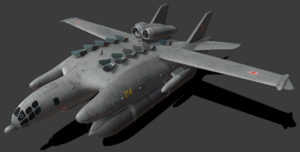User:Char/sandbox
| AITC-14 | |
|---|---|

| |
| Role | Amphibious anti-submarine seaplane |
| National origin | Aztapamatlan |
| Manufacturer | Axinitlan corporation |
| Designer | Micol Aketzalli |
| First flight | 17 September 1977 |
| Status | In service |
| Number built | 221 |
The Aketzalli Axinitlan AITC-14 Atl-Iohui Tlamanicuiztli (Seajet Surface Glider) is an Aztapaman anti-submarine aircraft in service with the Aztapaman Navy. It is notable for its unorthodox design created by the Aztapaman aeronautic engineer Micol Aketzalli, which is primarily intended to operate within the ground effect above land and especially over the surface of the ocean. While in the ground effect, the AITC-14 can reach speeds in excess of 750 kilometers per hour, cruise at 650 km/h and carry a payload of more than 20,000 kilograms. Unlike other Aztapaman surface glider designs, it is also capabale of conventional flight outside of the ground effect albeit with reduced speed and range with a service cieling of roughly 8,000 meters (26,000 ft). The main feature of surface gliders, and the principal advantage of the AITC-14 design created by Aketzalli is the capability to carry a heavy payload comparable to that of a ship at speeds competing with those of aircraft due to the aerodynamic advantages of traveling within the ground effect. The AITC-14 was the first military surface glider design and the first ground effect vehicle to reach wider success, demonstrating the viability of such a craft and the ambitious prosals of Micol Aketzalli for other uses to Axinitlan and other manufacturers.
Design
The design of the AITC-14 consists of a cental fuselage connected to two large pontoon structures on either side by large airfoils inside of which are mounted a series of downward facing turbofan engines to allow the craft to take off vertically, while forward propulsion is allocated to just two jet engines mounted on top of fuselage at the rear of the craft. Thanks to additional lift and reduced drag experienced in the ground effect, this would be more that sufficient to propell the large craft at high speeds. The design would lack landing gear, using its pontoons to land on water, marsh, sand, snow or other soft ground surfaces, and utilize its vertical take-off capabilities to operate without a runway or the equivalent aquatic take-off run required by conventional seaplanes. The final weaponized model would be equipped with depth charges, mines, aircraft torpedoes and would also be capable of carrying a payload of conventional aircraft bombs. To detect the advanced submarines that would be its primary targets, it is equipped with a magnetic anomaly detector, deployable sonobuoys, and an advaned trailing dipped hydrophone.
Development
Micol Aketzalli was a strong proponent of the potential of surface glider vehicles since his graduation from Tzopilopan Polytechnic Institute in 1967, but was unable to secure any interest to help develop his concept. This changed in 1971 when Aketzalli made a new proposal with military applications to the Axinitlan corporation, a prominent Aztapaman aircraft manufacturer that had until that point focused on civilian designs but was looking to expand into the lucrative market for military contracts. The AITC-14 was considered an enormous gamble for Axinitlan due to the significan jump in the company's technological capabilities that its design would require, including computerized fly-by-wire controls necessary to operate its VTOL system, the complex turbofan engines, and the general unorthodoxy of the revolutionary design which would require extensive development and testing. The chief of Axinitlan was also personally skeptical when he met Aketzalli, who revealed to him much more ambitious plans to develop much larger designs such as a truely colossal surface glider that could serve as airborne aircraft carriers that could travel at three or four times the speed of contemporary warships. However, the design would go ahead after Aketzalli presented the design to representatives of the Aztapaman Navy aviation corps on his own initiative and was able to impress the officials, who expressed their interest for the design directly to Axinitlan. This convinced the manufacturer that a succesful development of the AITC-14 would be financially worthwhile.
Development began in 1972 and would last until the final prototype was presented to the Aztapaman Navy for trials in 1977. While the main engines for forward propulsion were simple modifications of Axinitlan's existing turbofan designs for jet airliners, difficulties were encountered almost immedeately with the VTOL turbofan engines which the Axinitlan engineers were not experienced in designing or building. Issues were also encountered with the pontoons, which were originally intended to be inflatable using the exhaust from the turbofan engines and used to optionally land on water while the original design would be equipped with landing gear. The landing gear would later be scrapped and the design would go ahead relying only on its pontoons for landing and take-off.
Service History
Specifications
General characteristics
- Crew: 3
- Length: 25.97 m (85 ft 2 in)
- Wingspan: 30 m (98 ft 5 in)
- Height: 6.79 m (22 ft 3 in)
- Wing area: 217.79 m2 (2,344.3 sq ft)
- Empty weight: 24,000 kg (52,911 lb)
- Gross weight: 52,000 kg (114,640 lb)
- Powerplant: 2 × Zoqoloh F19 turbofan engines, 67 kN (15,000 lbf) thrust each (Cruise)
- Powerplant: 12 × Ihuiloxi X99 S1 turbofan engines, 43 kN (9,700 lbf) thrust each (VTOL)
Performance
- Maximum speed: 775 km/h (482 mph; 418 kn)
- Cruise speed: 650 km/h (404 mph; 351 kn)
- Range: 2,500 km (1,553 mi; 1,350 nmi)
- Service ceiling: 8,000 m (26,000 ft)